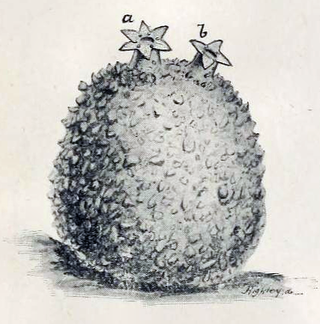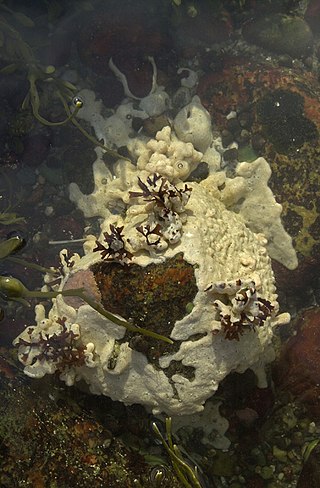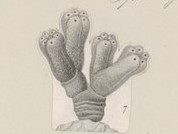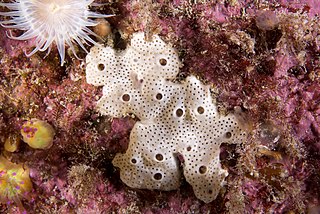
Ascidia is a genus of tunicates in the family Ascidiidae.

Herdmania is a genus of ascidian tunicates in the family Pyuridae.

Pyura is a large genus of sessile ascidians that live in coastal waters at depths of up to 80 m (260 feet). Like all ascidians, Pyura are filter feeders. A few species, including Pyura chilensis are commercially fished.
Sorberacea were a monoorder and monofamilial class of benthic Tunicates. The single order of the class was Aspiraculata, and the single family of that order was Hexacrobylidae. In a taxonomic revision of the Tunicata in 2007, the name "Hexacrobylidae" was declared invalid and members of the family were included in the family Molgulidae in the class Ascidiacea.

Ciona is a genus of sea squirts in the family Cionidae.

Botryllus is a genus of colonial ascidian tunicates in the family Styelidae.

Molgula, or sea grapes, are very common, globular, individual marine tunicates roughly the size of grapes.

Aplousobranchia is an order of sea squirts in the class Ascidiacea, first described by Fernando Lahille in 1886. They are colonial animals, and are distinguished from other sea squirts by the presence of relatively simple pharyngeal baskets. This provides the etymology of their name: in ancient greek, ἁ.πλοος-ους (ha.ploos-ous) means "simple". The posterior part of the abdomen contains the heart and gonads, and is typically larger than in other sea squirts.

Pycnoclavella diminuta, known as the white-spotted sea squirt, white-spot ascidian, and white-spotted ascidian, is a species of tunicate, in the genus Pycnoclavella. Like all ascidians, these sessile animals are filter feeders.

Aplidium is a genus of colonial sea squirts, tunicates in the family Polyclinidae. There are about 188 species in the genus found in shallow waters around the world.

Molgulidae is a family of tunicates in the class Ascidiacea. Following a revision in 2007, the family Hexacrobylidae was synonymized with Molgulidae.

Polyclinum is a genus of colonial sea squirts, tunicates in the family Polyclinidae.

Synoicum is a genus of colonial sea squirts, tunicates in the family Polyclinidae.
Aplidiopsis is a genus of colonial sea squirts, tunicates in the family Polyclinidae.
Eugyra are marine tunicates.
Pareugyrioides is a genus of marine tunicates.

Metandrocarpa is a genus of ascidian tunicates in the family Styelidae.

Lissoclinum is a genus of tunicates.

Leptoclinides is a genus of tunicates belonging to the family Didemnidae. The genus has a cosmopolitan distribution.

Trididemnum is a genus of tunicates belonging to the family Didemnidae.














